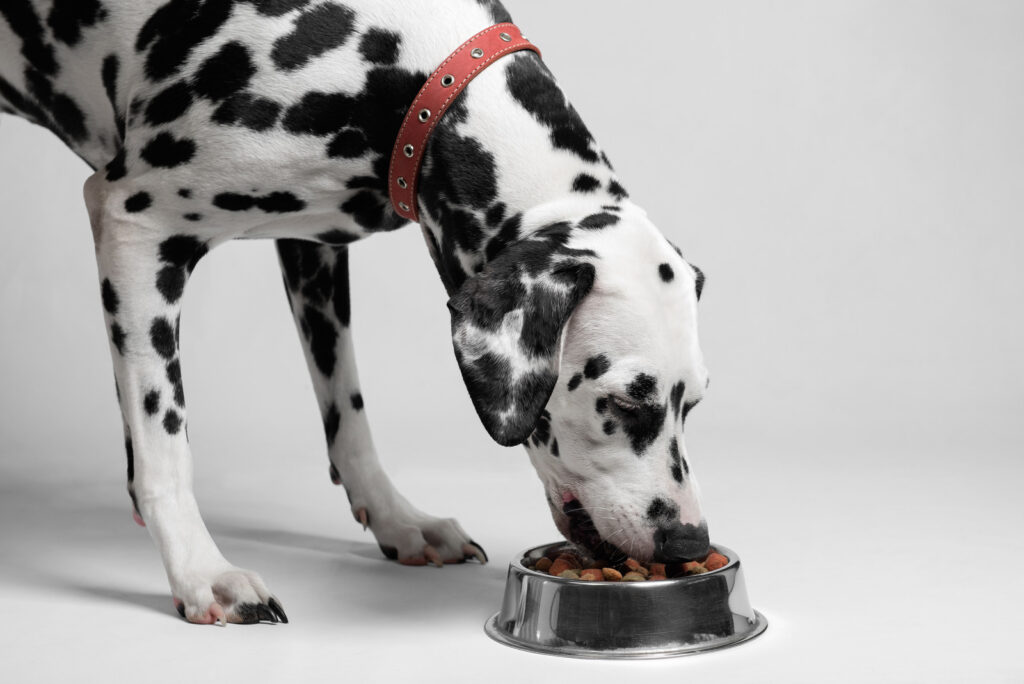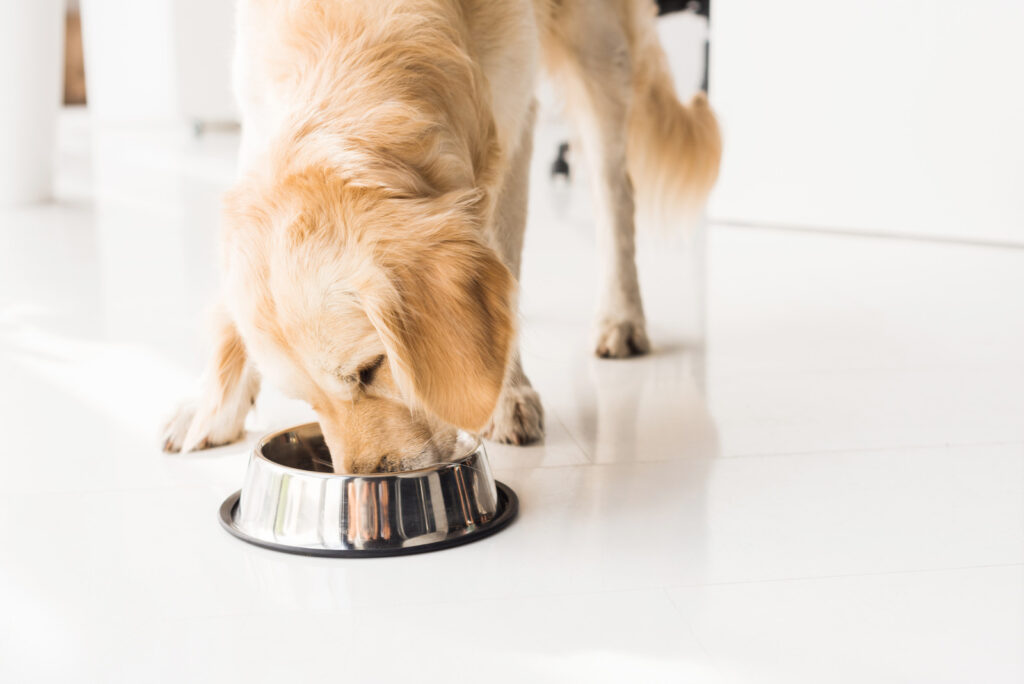Your guide to sensitive stomachs.
If your pooch suffers from tummy problems, you may be wondering what you can do to help them out. Should you change their diet, and if so, how? Should you be feeding them something classed as a hypoallergenic dog food? This can actually be a tricky question to answer, as there are lots of reasons for dog vomiting and diarrhoea and the right thing to do for your pet depends on the cause of their symptoms.
In general, it’s best to seek advice from your vet if your canine friend seems to be having persistent problems or is showing other signs of being unwell. If it turns out that your pet has a food allergy or a generally sensitive digestion, changing the diet can form part of a treatment plan that works wonders to set things to rights! Read on to find out more about sensitive stomachs.
Dog vomiting and diarrhoea
Dogs get tummy problems just like we do, and if you’ve ever had a poorly pooch you may have found yourself asking ‘why is my dog not eating?’ or ‘my dog keeps being sick, what should I do?’ In general, the right thing to do depends on the nature of the signs and how serious they are.
If your pet is normally healthy and they have a sudden acute bout of tummy troubles, it may well be that they’ve picked up something unsavoury on a walk that’s upset their digestion. However, bear in mind that there are other more serious causes of acute dog vomiting and diarrhoea, such as a gut blockage or poisoning. This means it’s best to judge what to do depending on how your pet is in themselves. If they seem fine and the tummy signs clear up quickly, they may recover well at home with small meals of bland food and some TLC. However, if the signs aren’t resolving or your pet is unwell, it’s safest to take them to the vet.
If your dog develops an upset stomach relatively frequently with no obvious cause, it’s also worth taking them to the vet to check for underlying issues. It may just be that your cheeky pooch keeps getting into mischief with scavenging, but there are a whole range of potential gut problems that may cause chronic tummy troubles. These include parasites, other infections, tumours, inflammatory bowel disease, food allergies… the list goes on! What’s more, problems in other organs such as the liver, kidney or pancreas can also cause dog vomiting and diarrhoea. Given the wide range of potential issues, it’s safest to have a chat with your vet to see if any of these are a concern. Your vet will be able to recommend what’s best to do and advise if it’s worth conducting any tests.

What if my dog is sensitive to certain foods?
Some dogs will be fine on certain foods but have a digestive upset if they eat others. If this is the case for your pet, your vet will be able to advise about the likely cause. It could be that your pet is allergic or intolerant to a particular ingredient in their food, or that they’ve got a delicate tummy meaning they’re sensitive to the levels of certain nutrients.
An example of sensitive digestion is that some dogs don’t cope so well with high-fat foods, so they can be sick if they eat food that is too rich in fat. Other dogs are very sensitive to the amount of fibre in the diet. In these cases, it’s not that the dog is unable to cope with a certain nutrient, it’s just that you can have too much (or too little) of a good thing! Sometimes just changing the amount of fat or fibre in the diet, adding in probiotics or prebiotics to help out the gut bacteria, or simply switching to a more digestible diet will help a dog who is prone to tummy troubles. The right diet always depends on the pet, but many dogs with a delicate digestion will do well on a special sensitivity diet.
Other dogs may have an intolerance or allergy to certain foods. With an allergy, the immune system overreacts to a particular element of the diet. A food intolerance can cause similar signs, but it’s technically different as the immune system doesn’t get involved. Probably the best-known example of this is lactose intolerance, where some dogs lack the enzyme ‘lactase’ that breaks down the sugar in milk and other dairy products. So, dogs with this condition will develop tummy signs after eating dairy, but they’ll be OK on other foods. While this kind of intolerance is not technically an allergy, the way of dealing with it is the same – avoid the food causing the signs!
Food allergies in dogs
So, what foods can dogs be allergic to? There are probably a hundred answers to this question, as it’s actually possible for a dog to develop an allergy to any protein they’ve eaten before. The most common dog food allergies are to ingredients that are frequently fed such as chicken, beef, lamb, dairy, eggs, wheat, soy and rice.
Dog food allergies tend to cause either tummy upsets, skin issues or both. Tummy signs can include dog vomiting and diarrhoea, flatulence or dog stomach gurgling, and soft stools. Skin problems related to allergies include itching and scratching, inflammation or redness to the skin, and recurrent ear infections. For all of these signs, there are a long list of other potential causes, and your vet will help you work out whether your pet’s issues are related to an allergy.
Finding out whether your dog has a food allergy
Establishing whether or not your pooch has a food allergy isn’t always the easiest thing to do, and your vet will be able to advise on the best course of action to take. If they suspect a food allergy, they may advise feeding an ‘exclusion diet’, otherwise known as a ‘dietary elimination trial’.
The idea here is to avoid all foods that the dog has previously eaten. The reason for this is that dogs can only be allergic to ingredients they’ve encountered before, as an allergy results from the immune system overreacting to something it’s previously met. So, eliminating all ingredients that a dog has eaten in the past should settle down the symptoms of an allergy.
For an exclusion diet, vets will generally pick a single protein source that the dog hasn’t previously eaten. For example, if your pooch has never had venison, then a diet based on this meat may be a good place to start. It’s important to consider the other elements of the diet too though – ideally, all ingredients should be new to the pet including carbohydrate sources like wheat and rice. Setting your pet up on a completely novel diet can be tricky, and it’s always worth seeking veterinary advice about this. If your vet is involved in choosing the diet, they’ll be better able to help your pet.
An alternative to feeding a novel protein source is to use a ‘hydrolysed’ diet where the meat protein has been broken down into pieces so small that they’re very unlikely to cause a reaction. Often, hydrolysed diets and other foods designed to help dogs with allergies will be called ‘hypoallergenic’.

What is a hypoallergenic diet?
A range of pet foods are now labelled as dog hypoallergenic diets, and this means they’re designed to be less likely to trigger allergy signs. So these diets will often contain a relatively limited list of ingredients, and they may avoid various potentially problematic ingredients such as wheat and lactose. Grain-free hypoallergenic dog diets can be great for pets with an allergy to wheat.
Some hypoallergenic diets are also specially formulated to be good for the skin and digestive system. Vitamins and omega 3 can be added for healthy skin, and the diets are often highly digestible to be kind to the gut.
However, the important thing to remember with hypoallergenic diets is that since dogs can be allergic to pretty much anything, no single diet will be right for every pet. For example, it wouldn’t help to feed a hypoallergenic chicken and rice diet to a dog with a chicken allergy! This is why it’s necessary to choose a diet based on what your pet has eaten in the past, avoiding the ingredients they’ve met before. It’s always best to do this in consultation with your vet.
How long should I persist with a diet trial for?
If you’re conducting a diet trial with your pet, it’s best to follow your vet’s instructions as to how long to persist. Often, vets will advise to stick to the new diet for two months or so and see if your dog’s skin or tummy signs improve. This may sound like quite a while, but it’s worth persisting with the diet for the full duration as it can take several weeks for allergy signs to improve in some pets. If you keep up with the diet for as long as your vet suggests, you can be confident of finding out whether food allergy is an issue for your pet.
It is important to be strict with the diet during the trial period as it only takes a little bit of a problem ingredient to trigger allergy signs. Sadly, this means no titbits and no treats, unless you’ve checked all the ingredients of these with your vet.
If your pet’s skin or tummy signs settle down on the diet trial, your vet may recommend introducing other types of food back in to see if your pet has a reaction. This will help you work out what foods you can feed your pet long term.
Love your pets? So do we! Join in the conversation over on our Facebook page.


